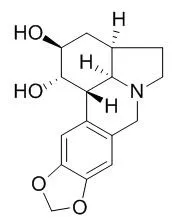| In vivo: |
| Journal of Yunyang Medical College, 2002 , 21 (2) :71-72. | | Protective Effects of Dihydrolycorine on the Anoxia Brain Damage in Rat[Reference: WebLink] | To investigate the effect of Dihydrolycorine on anoxia brain damage in rats.
METHODS AND RESULTS:
The model of hyperbicarbonatemia was used by stopping respirator to record the reemerge time and recovery percentage of EEG during reoxygenation for 10 minutes. Results The recovery percentage of control, DL(20 mg/kg), DL(40 mg/kg), nimodipine group is respectively (32.15±33.68)%, (75.40±17.12)%, (62.50±15.81)%, (80.00±12.26)%, which showed that the drug administered markedly improved recovery of the amplitude of EEG after reoxygenation compared with the controls.
CONCLUSIONS:
It suggests that DL and nimodipine protects against anoxia damage of brain in rat. | | Biochim Biophys Acta. 1976 Mar 17;425(3):342-8. | | Inhibitors of protein synthesis in eukarytic cells. Comparative effects of some amaryllidaceae alkaloids.[Pubmed: 944052] |
METHODS AND RESULTS:
The effects of eighteen compounds obtained from bulbs of the Amaryllidaceae family were tested on (a) animal cell growth, (b) DNA, RNA and protein synthesis by intact cells and (c) protein synthesis in cell-free systems. Dihydrolycorine, haemanthamine, lycorine, narciclasine, pretazettine and pseudolycorine halted HeLa cell growth at 10(-1) mM or lower concentrations. These compounds at their growth inhibitory concentrations block protein synthesis in ascites cells and stabilize HeLa cell polysomes in vivo. Endomyocarditis virus RNA-directed cell-free polypeptide synthesis by an ascites S-30 extract and acetyl-[14C]leucyl-puromycin formation by ascites ribosomes are also inhibited by the six compounds indicated above.
CONCLUSIONS:
It is therefore concluded that they halt protein synthesis in eukaryotic cells by inhibiting the peptide bone formation step. |
|






 Cell. 2018 Jan 11;172(1-2):249-261.e12. doi: 10.1016/j.cell.2017.12.019.IF=36.216(2019)
Cell. 2018 Jan 11;172(1-2):249-261.e12. doi: 10.1016/j.cell.2017.12.019.IF=36.216(2019) Cell Metab. 2020 Mar 3;31(3):534-548.e5. doi: 10.1016/j.cmet.2020.01.002.IF=22.415(2019)
Cell Metab. 2020 Mar 3;31(3):534-548.e5. doi: 10.1016/j.cmet.2020.01.002.IF=22.415(2019) Mol Cell. 2017 Nov 16;68(4):673-685.e6. doi: 10.1016/j.molcel.2017.10.022.IF=14.548(2019)
Mol Cell. 2017 Nov 16;68(4):673-685.e6. doi: 10.1016/j.molcel.2017.10.022.IF=14.548(2019)